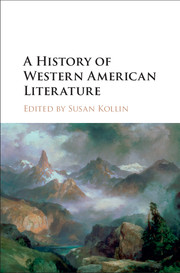Book contents
- Frontmatter
- Contents
- Notes on Contributors
- Acknowledgments
- Introduction: Historicizing the American Literary West
- PART I HOMELANDS
- PART II MAKING A REGION
- PART III GEOGRAPHIES OF THE LITERARY WEST
- PART IV THE TWENTIETH CENTURY AND BEYOND: LITERARY MOVEMENTS AND CRITICAL PERSPECTIVES
- 14 Early Cinematic Westerns
- 15 The Environmental Novel of the American West
- 16 Hard-Boiled Fiction and Noir Narratives
- 17 The Beats and the American West
- 18 Contested Wests: Indigenous Americans and the Literature of Sovereignty
- 19 Asian American Writers and the Making of the Western U.S. Landscape
- 20 African American Literature: Recasting Region through Race
- 21 Hollywood Westerns: 1930s to the Present
- 22 Urban New Wests
- 23 Queer Frontiers: Gender and Sexuality in the American West
- 24 Postwestern Literature and Criticism
- Selected Bibliography
- Index
14 - Early Cinematic Westerns
from PART IV - THE TWENTIETH CENTURY AND BEYOND: LITERARY MOVEMENTS AND CRITICAL PERSPECTIVES
Published online by Cambridge University Press: 05 November 2015
- Frontmatter
- Contents
- Notes on Contributors
- Acknowledgments
- Introduction: Historicizing the American Literary West
- PART I HOMELANDS
- PART II MAKING A REGION
- PART III GEOGRAPHIES OF THE LITERARY WEST
- PART IV THE TWENTIETH CENTURY AND BEYOND: LITERARY MOVEMENTS AND CRITICAL PERSPECTIVES
- 14 Early Cinematic Westerns
- 15 The Environmental Novel of the American West
- 16 Hard-Boiled Fiction and Noir Narratives
- 17 The Beats and the American West
- 18 Contested Wests: Indigenous Americans and the Literature of Sovereignty
- 19 Asian American Writers and the Making of the Western U.S. Landscape
- 20 African American Literature: Recasting Region through Race
- 21 Hollywood Westerns: 1930s to the Present
- 22 Urban New Wests
- 23 Queer Frontiers: Gender and Sexuality in the American West
- 24 Postwestern Literature and Criticism
- Selected Bibliography
- Index
Summary
What first made westerns cinematic? If we start with the transition from print to film at the turn of the twentieth century, the first answer is “Indians” and the second, shoot-outs. A different starting point would deliver another answer – most obviously, a focus on visual arts would lead to landscape, which is central to many major studies of westerns. How we get from one medium to the other also affects visibility and meaning. Here, I treat live performance as the lynchpin. In parts one and two, I follow Native presences from print to performance to movies, then, in part three, trace the emergence of the man-to-man shoot-out by the same route. These partially reconstructed origin stories revise the look of the genre in several senses.
From a Lakota Gaze to “Indian and Western” Films
On September 24, 1894, Thomas Edison took some Lakota performers from Buffalo Bill's Wild West (currently playing in Ambrose Park, Brooklyn) to his Black Maria studio in West Orange, New Jersey, where they were filmed dancing, drumming, and chanting. This was the first time that Native performers had appeared before a moving camera, in this case the Kinetograph. Among the shorts shot that day is the mesmerizing fifteen-second Buffalo Dance. As Last Horse, Parts His Hair, and Hair Coat dance – bobbing, strutting, and weaving rhythmically in front of two drummers – one of them barely takes his eyes off the camera, turning and twisting to keep his gaze unbroken and, at one point, brandishing his stick directly at the lens. There are several ways to read this “provocative visual address.” Perhaps the dancer was simply going through the motions taught in Buffalo Bill's Wild West, by which Native performers mimicked “dangerous antagonists” for audience titillation. Perhaps he was reveling in the “harnessing of visibility,” the “exhibitionist confrontation” that Tom Gunning reads as the unique power of the first moving pictures, with actors recurrently looking at the camera and soliciting spectators’ attention. Perhaps he shook his stick defiantly at the federal forces that had forbidden first the Lakota, later Indigenous peoples more generally, to dance; perhaps he communicated a message comprehensible only to Indigenous spectators. Or perhaps he was “laughing at the camera,” in the manner identified by the Seneca film scholar Michelle Raheja of another Indigenous performer, the Inuit actor Allakariallak, in the 1922 film, Nanook of the North.
- Type
- Chapter
- Information
- A History of Western American Literature , pp. 225 - 241Publisher: Cambridge University PressPrint publication year: 2015



